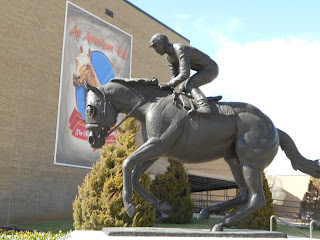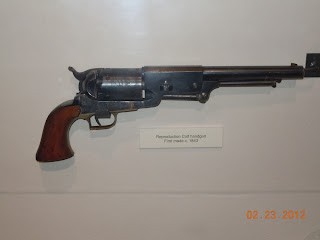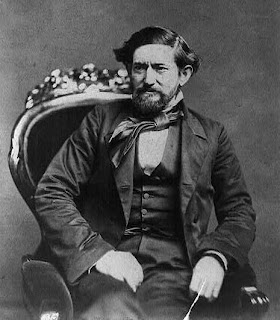 The American Quarter Horse Hall of Fame and Museum is located in Amarillo Texas directly off Interstate 40. When you're looking for things to do in Amarillo, it's a great stop. A perfect addition to your western road trip or vacation. It's also at the headquarters of the American Quarter Horse Association and makes a perfect stop on your western road trip or vacation.
The American Quarter Horse Hall of Fame and Museum is located in Amarillo Texas directly off Interstate 40. When you're looking for things to do in Amarillo, it's a great stop. A perfect addition to your western road trip or vacation. It's also at the headquarters of the American Quarter Horse Association and makes a perfect stop on your western road trip or vacation.World's Largest Equine Breed Registry
The American Quarter Horse Association is the world’s largest equine breed registry and membership organization. If your trip west happens to take you through Amarillo Texas you'll want to add this to your trip planner. It's a fascinating museum that you'll enjoy whether you're a horse owner or not. The museum showcases all the history there is on the Quarter Horse. One of it's interior rooms is the Grand Hall, which according to the AQHA houses the legends of American Quarter Horse history: the people and horses inducted into the American Quarter Horse Hall of Fame who have paved the way for the future. Another area is the Kenneth Banks Theater / Club Room whose artwork shows a variety of American Quarter Horses famous in the bloodlines of today’s champions. The artwork was created by well known Western artist, the late Orren Mixer. In front of the museum when you arrive you'll view larger than life bronze statues of history making American Quarter Horses Rugged Lark and Refrigerator. The Quarter Horse sculptures are beautiful.
The American Quarter Horse
The American Quarter Horse is known as a breed of horse that is excellent at sprinting short distances. The name Quarter Horse means that this breed has the ability to outrun other horses at distances of a quarter mile or less. The American Quarter Horse is a well muscled and compact horse. You've seen them everywhere. They are seen in rodeos, on ranches and have been used extensively in western movie productions. There are seventeen recognized colors of Quarter Horses. The most seen color is sorrel or brownish-red.
The ancestry of the Quarter Horse is very interesting. The origin of this breed of horse goes all the way back to colonial America. The colonists in the north used the English horse both for work as well as racing. Their brothers in the south were searching for a faster horse and they found it among the Chickasaw Indians. These fast ponies were called "Spanish Barbs" and they came to North America from the Spaniards through Florida. These same breed of horses were used later by Cortez in Mexico. The Spanish Barb was a cross breed between the North African Barb and the native Spanish horse. The North African Barb was introduced to the Iberian Peninsula with the invasion by the Moors and thus the Barb Horse in Spain.
 |
| Dash for Cash and Jerry Nicodemus |
In his prime, Peter was 16 hands and 1,430 pounds. This bay stallion was the fastest 2 year old of his era in America. The historic racehorse, Peter McCue, gave birth to two of the original nineteen foundation sires found in the American Quarter Horse Association Studbook.
A list of Peter McCue's offspring include Hickory Bill, A D Reed, Shiek P-11, Chief P-5, Harmon Baker, John Wilkens and Jack McCue.
The very interesting book, The Schooling of the Horse by author John Richard Young, offers an answer to the question...What is a Quarter Horse? The answer put forward states that a Quarter Horse is primarily a race horse. A superb sprinter up to distances of a quarter mile. Fanciers are not concerned with the weight carrying capacity, the stock working ability, or even the breeding of the kind of horse they favor. The horse may be a Thoroughbred. The horse's temperament may make him unsuitable for any work except racing. Those that favor this type of horse... that is all that matters. What's important is how fast he can run under a very light weight on a groomed track.
 |
| Cowboy and His Horse by artist Jim Reno |
You may also be interested in our Western Trips article about the western ranch cowboy and his gear on the link below...
Western Cowboy Gear for the Round Up
The Quarter Horse should be strong enough to carry a big man over rough country all day. To people who wanted this kind of horse, this represented the true Quarter Horse. Today, there is a more middle of the road Quarter Horse that is smoothly muscled and athletic. Rodeo contestants now largely favor this type. It's thought that this type of Quarter Horse usually has a good amount of Thoroughbred blood.
What's interesting is that someone who still favors the chunky, bulldog type of horse would never think of the middle of the road variety as being a real Quarter Horse. It's obvious from the information above that there are several definitions of the Quarter Horse. A lot appears to depend on what you prefer in a horse. The book The Schooling of the Horse also suggests that there is not hardly a Quarter Horse breeder that will not admit that the Quarter Horse is essentially a cow horse and the best cow horse in the world and that he won his reputation as such the hard way. Someone who is contemplating purchasing a Quarter Horse really needs to determine what type of horse he or she prefers.
 |
| Quarter Horse Wimpy |
Defining a Quarter Horse
The question that might be asked is...What is a true Quarter Horse? The question really doesn't have a concrete answer. Some adhere strictly to the horses pigmentation. Others will use the horses speed as a abswer the question. Yet others will make the judgement on the horses ability to handle range stock.
A visit to the American Quarter Horse Hall of Fame and Museum will give you much more information to help make your own determination.
Visit the American Quarter Horse Hall of Fame and Museum
The American Quarter Horse Hall of Fame and Museum is located at 2601 E. Interstate 40 in Amarillo Texas. The museum is operated by the American Quarter Horse Foundation which is the charitable organization of the American Quarter Horse Association. The American Quarter Horse Hall of Fame & Museum is a great place to bring Texas Panhandle visitors and vacationers where they can experience a piece of the West. As they say, if you're looking for stuff to do in Amarillo, this museum is one of the best.
Two other Amarillo Texas area historic points of interest are detailed in the following articles. The historic Charles Goodnight Home. Rancher Charles Goodnight is known as the Father of the Texas Panhandle. The Goodnight Home is located in Goodnight Texas, about 42 miles southeast of Amarillo. Another is the beautiful and historic Palo Duro Canyon just a short drive south of Amarillo.
(Photos are from author's private collection and article under copyright Western Trips)





.jpg)


























